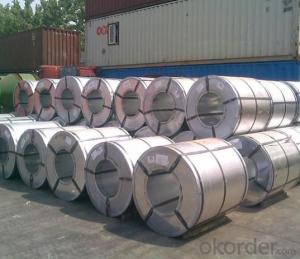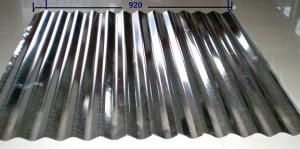Hot dipped color coated Galvanized steel from China, CNBM, fast delivery
- Loading Port:
- China main port
- Payment Terms:
- TT OR LC
- Min Order Qty:
- 1 m.t.
- Supply Capability:
- 100000 m.t./month
OKorder Service Pledge
OKorder Financial Service
You Might Also Like
1) AVAILABLE DESIGNATION OF (Prepainted galvanized steel coils) printed PPGI coils
Quality Q/BQB 440-2003 JIS G3312-1994 EN 10326-2004 ASTM A653-02a
EN 10327-2004 (BASE PLATE)
(BASE PLATE)
Commercial Steel TDC51D CGCC DX51D+Z/AZ CS Type A/B/C
Forming Steel (TSt01,TSt02,TSt03) CGCD1 FS Type A, Type B
Drawing TDC52D /TDC53D - DX52D+Z/AZ DDS TYPE A/C
Steel DX53D+Z/AZ
Structural TS280GD(TStE28) CGC400 S280D+Z/AZ SS275
Steel TS350GD(TStE34) CGC440 S350D+Z/AZ SS340 Class1
2) OUR SPECIFICATION OF (Prepainted galvanized steel coils) printed PPGI coils
Available Size:
Manufacturer Thickness Width Length of plate Inner diameter of coil
JIANGSU HUIYE STEEL SHEET CO.,LTD 0.2-1.2mm 800/914/1000/1200/1219/1250mm 1000-6000mm 508mm/610mm
Coated Mass OF (Prepainted galvanized steel coils) printed PPGI coils:
Base plate Available Coated Mass(g/m^2)
Galvanized Steel 80, 100, 120, 160, 180
Galvalume Steel 50, 70, 150
Available Painting OF (Prepainted galvanized steel coils) printed PPGI coils:
Category of Painting Item Code
Polyester PE
High-durability polyester HDP
Silicon modified polyesters SMP
Polyvinylidene fluoride PVDF
Easy-Cleaning —
Painting Thickness Top side: 20+5microns;
Bottom side: 5~7microns.
Color System Produce according to RAL Color System or as per buyer’s color sample.
Painting structure Top surface Bottom surface
Primer coating No coating 1/0
Primer coating Primer coating 1/1
Primer coating + Finish coating No coating 2/0
Primer coating + Finish coating Primer coating or single back coating 2/1
Primer coating + Finish coating Primer coating + Finish back coating 2/2
- Q: How do steel sheets compare to other materials like aluminum or plastic?
- Steel sheets are generally stronger and more durable compared to aluminum or plastic sheets. They have a higher tensile strength and can withstand heavier loads. However, steel sheets are heavier and may require additional support structures. Aluminum sheets are lightweight and have good corrosion resistance but are not as strong as steel. Plastic sheets are lightweight and inexpensive, but they lack the strength and durability of steel or aluminum. Ultimately, the choice between steel, aluminum, or plastic sheets depends on the specific application and requirements.
- Q: Can steel sheets be used in corrosive environments like saltwater?
- Yes, steel sheets can be used in corrosive environments like saltwater. However, the type of steel and the level of corrosion resistance it offers will determine its suitability for such conditions. Stainless steel, for example, is highly resistant to corrosion and is often used in marine and saltwater environments. It contains chromium, which forms a protective layer on the surface of the steel, preventing it from reacting with the saltwater. Other types of steel, such as carbon steel, may also be used in saltwater environments, but they require additional protective coatings or treatments to prevent corrosion. Regular maintenance and proper care are essential to ensure the longevity of steel sheets in corrosive environments like saltwater.
- Q: Are steel sheets easy to install?
- Yes, steel sheets are generally easy to install as they are lightweight and come in various sizes, allowing for easy handling and maneuverability during installation. Additionally, steel sheets often have pre-drilled holes or slots, facilitating the installation process.
- Q: How do steel sheets perform in electrical resistance?
- Steel sheets are not good conductors of electricity and have relatively high electrical resistance compared to other materials such as copper or aluminum.
- Q: Are steel sheets vulnerable to UV radiation?
- Yes, steel sheets are generally not vulnerable to UV radiation.
- Q: What are the different forms of steel sheets (flat, perforated, expanded, etc.)?
- Some different forms of steel sheets include flat sheets, perforated sheets, expanded sheets, and corrugated sheets.
- Q: Are steel sheets suitable for food-grade applications?
- Yes, steel sheets are suitable for food-grade applications. Stainless steel sheets, in particular, are commonly used in the food industry due to their excellent corrosion resistance, durability, and ease of cleaning. They meet the necessary hygiene standards and are non-reactive with food, making them a suitable choice for food processing, storage, and transportation.
- Q: What is the average thickness of galvanized steel sheets?
- The average thickness of galvanized steel sheets can vary depending on the specific application and industry standards. However, commonly available galvanized steel sheets typically range in thickness from around 0.4 millimeters to 3.175 millimeters. It is important to note that thicker galvanized steel sheets are often used for more heavy-duty applications, such as construction and industrial purposes, while thinner sheets may be suitable for lighter applications like automotive or household appliances. Additionally, it is advisable to consult the relevant industry standards or manufacturers' specifications for precise thickness requirements for specific applications.
- Q: What are the uses of steel sheets?
- Steel sheets have a wide range of uses in various industries such as construction, automotive, manufacturing, and aerospace. They are commonly used for building structures, roofing, walls, and foundations due to their strength and durability. Steel sheets are also utilized in the production of automobiles, appliances, machinery, and equipment as they provide a strong and lightweight material. Additionally, they are used for fabricating containers, storage tanks, and pipelines due to their resistance to corrosion.
- Q: What is Larson steel sheet pile?"
- The advantages of Larson steel sheet piles1. high quality (high strength, light, good water resistance);2., simple construction, shorten the period of time, good durability, life of more than 50 years;3. construction cost is cheap, interchangeability is good, can be reused 58 times;4., the construction has remarkable environmental protection effect, greatly reduces the amount of soil sampling and the use of concrete, and effectively protects the land resources;5., the timeliness of disaster relief is stronger, such as flood control, landslides, subsidence, quicksand and so on;6. Deal with and solve a series of problems in the process of excavation;7, for the construction task, it can reduce the space requirements;8, the use of steel sheet pile provides the necessary safety, and timeliness;9, the use of steel piles can be free from weather conditions;10, the use of steel sheet pile material can simplify the complexity of inspection materials and system materials;
Send your message to us
Hot dipped color coated Galvanized steel from China, CNBM, fast delivery
- Loading Port:
- China main port
- Payment Terms:
- TT OR LC
- Min Order Qty:
- 1 m.t.
- Supply Capability:
- 100000 m.t./month
OKorder Service Pledge
OKorder Financial Service
Similar products
Hot products
Hot Searches
Related keywords
































